
Deerhurst is a village and civil parish in Gloucestershire, England, about 2 miles (3 km) southwest of Tewkesbury. The village is on the east bank of the River Severn. The parish includes the village of Apperley and the hamlet of Deerhurst Walton. The 2011 Census recorded the parish's population as 906, the majority of whom live in Apperley.

Anglo-Saxon architecture was a period in the history of architecture in England from the mid-5th century until the Norman Conquest of 1066. Anglo-Saxon secular buildings in Britain were generally simple, constructed mainly using timber with thatch for roofing. No universally accepted example survives above ground. Generally preferring not to settle within the old Roman cities, the Anglo-Saxons built small towns near their centres of agriculture, at fords in rivers or sited to serve as ports. In each town, a main hall was in the centre, provided with a central hearth.

The Malvern Hills are in the English counties of Worcestershire, Herefordshire and a small area of northern Gloucestershire, dominating the surrounding countryside and the towns and villages of the district of Malvern. The highest summit affords a panorama of the Severn Valley, the hills of Herefordshire and the Welsh mountains, parts of thirteen counties, the Bristol Channel, and the cathedrals of Worcester, Gloucester and Hereford.

Malvern is a spa town and civil parish in Worcestershire, England. It lies at the foot of the Malvern Hills, a designated Area of Outstanding Natural Beauty. The centre of Malvern, Great Malvern, is a historic conservation area, which grew dramatically in Victorian times due to the natural mineral water springs in the vicinity, including Malvern Water.

The London Charterhouse is a historic complex of buildings in Farringdon, London, dating back to the 14th century. It occupies land to the north of Charterhouse Square, and lies within the London Borough of Islington. It was originally built a Carthusian priory, founded in 1371 on the site of a Black Death burial ground. Following the priory's dissolution in 1537, it was rebuilt from 1545 onwards to become one of the great courtyard houses of Tudor London. In 1611, the property was bought by Thomas Sutton, a businessman and "the wealthiest commoner in England", who established a school for the young and an almshouse for the old. The almshouse remains in occupation today, while the school was re-located in 1872 to Godalming, Surrey.

Great Malvern is an area of the spa town of Malvern, Worcestershire, England. It lies at the foot of the Malvern Hills, a designated Area of Outstanding Natural Beauty, on the eastern flanks of the Worcestershire Beacon and North Hill, and is the historic centre of Malvern and includes its town centre.
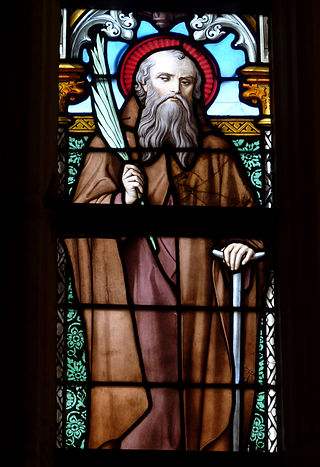
Saint Helier was a 6th-century ascetic hermit. He is the patron saint of Jersey in the Channel Islands, and in particular of the town and parish of Saint Helier, the island's capital. He is also invoked as a healing saint for diseases of the skin and eyes.
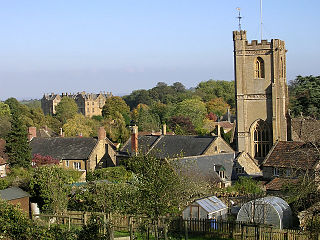
Montacute is a village and civil parish in Somerset, England, 4 miles (6.4 km) west of Yeovil. The village has a population of 831. The name Montacute is thought by some to derive from the Latin "Mons Acutus", referring to the conically acute St Michael's Hill dominating the village to the west. An alternative view is that it is named after Drogo de Montagu, whose family originated from Montaigu-les-Bois, in the arrondissement of Coutances. Mortain held Montacute after 1066, Drogo was a close associate.

Great Malvern Priory in Malvern, Worcestershire, England, was a Benedictine monastery and is now an Anglican parish church. In 1949 it was designated a Grade I listed building. It is a dominant building in the Great Malvern Conservation area. It has the largest display of 15th-century stained glass in England, as well as carved miserichords from the 15th and 16th century and the largest collection of medieval floor and wall tiles. In 1860 major restoration work was carried out by Sir George Gilbert Scott. It is also the venue for concerts and civic services.
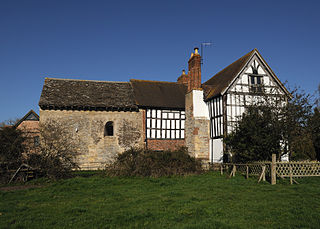
Odda's Chapel is a former chantry chapel at Deerhurst, Gloucestershire. It is an 11th-century late Anglo-Saxon building, completed a decade before the Norman Conquest of England.

St Mary's Priory Church, Deerhurst, is the Church of England parish church of Deerhurst, Gloucestershire, England. Much of the church is Anglo-Saxon. It was built in the 8th century, when Deerhurst was part of the Anglo-Saxon kingdom of Mercia. It is contemporary with the Carolingian Renaissance on mainland Europe, which may have influenced it.

St. Ann's Well is set on the slopes of the Malvern Hills above Great Malvern. It is a popular site on a path leading up to the Worcestershire Beacon and lies on the final descent of the Worcestershire Way. The spring or well is named after Saint Anne, the maternal grandmother of Christ and the patron saint of many wells. A building that dates back to 1813 houses the well or spring. Malvern water flows freely from an elaborately carved water spout. The building also hosts a cafe. During the early 20th century, the now-defunct Burrows company bottled and sold Malvern Water from this source under the "St Ann's Well" brand.

Malvern water is a natural spring water from the Malvern Hills on the border of the counties of Herefordshire and Worcestershire in England. The Hills consist of very hard granite and limestone rock. Fissures in the rock retain rain water, which slowly permeates through, escaping at the springs. The springs release an average of about 60 litres a minute and the flow has never been known to cease.
Among the places of worship in the town and area of Malvern, Worcestershire are centres of dedication to many faiths and denominations. The town has 31 Christian churches with 11 belonging to the Church of England, ranging from low church to high Anglo-Catholic, two Roman Catholic, one Evangelical, and the others being Non-Conformist and other faiths. Its oldest place of worship is the almost cathedral sized parish church of Great Malvern Priory which is all that remains of the former 10th century abbey in central Malvern, which according to the Worcester Monastic Annals, work began in 1085. The chain of Malvern Hills lies in a north-south direction, thus posing a challenge for the architects of Christian churches located on the steep slopes, chancels being traditionally sited at the east end of the building. Many churches were built in the 19th century concomitant with the rapid expansion of the town due to its popularity as a spa. A few modern buildings such as St Mary's Church (1960) in Sherrard's Green, have been constructed in the second half of the 20th century, and some churches, notably St Andrews in Poolbrook, have had important modern extensions added during the first decade of the 21st century.

Raggedstone Hill is situated on the range of Malvern Hills that runs approximately 13 kilometres (8 mi) north-south along the Herefordshire-Worcestershire border. Raggedstone Hill lies close to the borders of Herefordshire, Worcestershire and Gloucestershire. It has an elevation of 254 metres (833 ft).
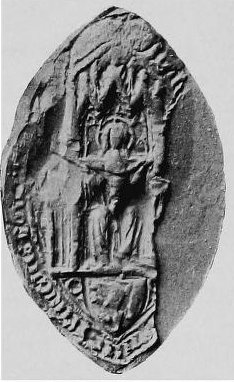
Markyate Priory was a Benedictine priory in Bedfordshire, England. It was established in 1145 and disestablished in 1537.

Lammana Priory was a priory on Looe Island in Cornwall, UK, consisting of two Benedictine monks until 1289. It was owned by Glastonbury Abbey and the property was sold in 1289 to a local landowner.

English Martyrs Church or its full name The Church of St Thomas of Canterbury and the English Martyrs is a Roman Catholic Parish church in Preston, Lancashire. It was designed by Edward Welby Pugin and is under the administration of the Diocese of Lancaster. It is near to Preston city centre and stands on the corner of the A6, between Aqueduct Street and St George's Road. Since 2017, it has been in the care of priests from the Institute of Christ the King Sovereign Priest.
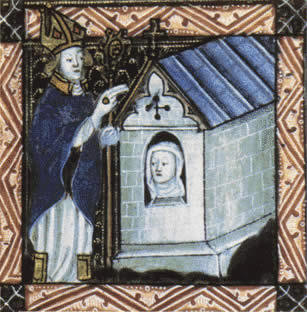
Lucy de Newchurch was an anchoress from the diocese of Hereford who lived in a chapel dedicated to St. Brendan on Brandon Hill in Bristol and who later became of interest to antiquarians, historians of Bristol, and writers of Bristol guide books. She was the first known of four hermits who lived on Brandon Hill at various times between 1314 and 1480.
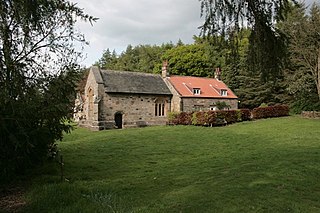
The Shrine of Our Lady of Mount Grace is a place of Marian devotion and pilgrimage sited in the North Yorkshire village of Osmotherley. Christians have visited this small church, known as the “Lady Chapel”, for centuries and continue the tradition through an annual pilgrimage every summer on the Sunday nearest the Feast of the Assumption, 15 August.



















